|
BUY NOW
Back
$600-$750
$450-$550
$800-$1000 |
Katsina dolls are an important and cherished part of the
Hopi culture. These dolls are representations of one of the
hundreds of Katsinam, or Hopi spirit guides, who are believed to
live primarily in the San Francisco Peaks of Arizona. They
descend from the mountains as the winter season wanes to help
villagers tend to the fields, care for the children, and tackle
any other major task required to encourage the community and
land to flourish. The Katsinam stay through late July when the
planting and growing seasons have ended. At that time they take
their leave of the Hopi and return to their home in the
mountains of Arizona. During the time that the Katsinam are
visiting the Hopi villages, numerous dances are held to both
celebrate a particular natural event or remind the people of the
village of the significant presence of the Katsinam, and to help
the children learn about these sacred beings and what each of
them represents. During these dances, the Hopi men will don
costumes and will "personate" an individual Katsina, which is
represented by a specific mask, color patterns and physical
characteristics. Full-figure Katsinam are carved, to represent a
specific Katsina and to help the child become acquainted with
that particular spirit. These full-figure carvings, referred to
as dolls, are carefully carved from the strong, light root of
the cottonwood tree and then painted with the particular colors
of the specific Katsina the doll represents.
|
|
What are Kachinas? There are hundreds
of Hopi Katsinam, "personations" of supernatural beings,
important animals and ancestors who help the Hopi people raise
their crops, their children, and their spirits. The Katsina
dancers are men wearing masks--each of which represents a
particular Katsina--and paint and feathered costumes. Everyone
in the village, aside from the children, knows that the Katsina
dancers are actually men from the village, though Katsinam are
still believed to have supernatural powers. Much of the value in
these dances is found to be instructing the young. Signed and
numbered.
|
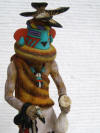 Aha or Kuzrua is
one of the Chief Katsinam of Second Mesa and appears only on
this mesa during Bean Dance. He appears in a short Kiva rite
after the performance of the Qoqoqlo, Ahola, Eototo and
Kokosori when they bless the village. 6.5" Malcolm Fred $750
Native American Hopi Carved Aha Chief Katsina Doll by Malcolm
Fred Aha or Kuzrua is
one of the Chief Katsinam of Second Mesa and appears only on
this mesa during Bean Dance. He appears in a short Kiva rite
after the performance of the Qoqoqlo, Ahola, Eototo and
Kokosori when they bless the village. 6.5" Malcolm Fred $750
Native American Hopi Carved Aha Chief Katsina Doll by Malcolm
Fred |
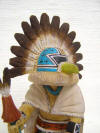 The Ahola is
a Hopi Chief Katsina of very high order. He is considered an
elder and a very wise chief. The Ahola appears at the Bean
Dance (Powamuya) ceremony to open the beginning of the
Katsina season. The Ahola brings prayers for a long and
healthful life. The Ahola and Ahola Mana go from house to
house, making their appearance. On the outside walls of each
home, the Ahola draws four horizontal marks with corn meal.
The women inside the house come out and sprinkle
the Ahola with cornmeal and at the same time take some corn
seeds from the Ahola Mana's basket. The two leave and go to
the kiva entrance and face each other. He holds his staff
out for support and strength and bends his right knee and
continues kneeling in rhythmic motion. He calls out to the
kiva chief and the two discuss the arrival of the Katsinam
for the year. 9" $750
Native American Hopi Carved Ahola Chief Katsina Doll by
Henry Naha The Ahola is
a Hopi Chief Katsina of very high order. He is considered an
elder and a very wise chief. The Ahola appears at the Bean
Dance (Powamuya) ceremony to open the beginning of the
Katsina season. The Ahola brings prayers for a long and
healthful life. The Ahola and Ahola Mana go from house to
house, making their appearance. On the outside walls of each
home, the Ahola draws four horizontal marks with corn meal.
The women inside the house come out and sprinkle
the Ahola with cornmeal and at the same time take some corn
seeds from the Ahola Mana's basket. The two leave and go to
the kiva entrance and face each other. He holds his staff
out for support and strength and bends his right knee and
continues kneeling in rhythmic motion. He calls out to the
kiva chief and the two discuss the arrival of the Katsinam
for the year. 9" $750
Native American Hopi Carved Ahola Chief Katsina Doll by
Henry Naha |
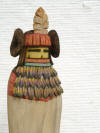 The Katsin
Mana, or Katsina Maiden, is the most ubiquitous of all the women
who appear with other Katsinam. If she is carrying yellow corn,
she is known as the Yellow Corn Maiden, similarly blue corn,
etc. This is a Yellow Corn Maiden. She also changes her name to
that of the Katsina with whom she is dancing, although her
appearance does not change. Her presence is a prayer for a
bountiful corn harvest. 11.5" $600 Native American Hopi
Carved Yellow Corn Maiden Katsina Doll by Ron Honyouti The Katsin
Mana, or Katsina Maiden, is the most ubiquitous of all the women
who appear with other Katsinam. If she is carrying yellow corn,
she is known as the Yellow Corn Maiden, similarly blue corn,
etc. This is a Yellow Corn Maiden. She also changes her name to
that of the Katsina with whom she is dancing, although her
appearance does not change. Her presence is a prayer for a
bountiful corn harvest. 11.5" $600 Native American Hopi
Carved Yellow Corn Maiden Katsina Doll by Ron Honyouti |
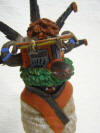 The
Badger (Honan) has great knowledge of roots and herbs and is
sought for his wisdom and his ability to cure the sick by using
herbal potions. The Badger Katsina appears in the summer dances.
He is not only a healer and a chief; he also dances for rain for
the crops. He appears at all three Mesas. This wonderful carving
by Keith Torres shows the Badger from Second Mesa dancing,
wrapped in a manta to keep warm, in the cold desert mornings.
11" $675 Native American Hopi Carved Badger Healer Katsina
Doll by Keith Torres The
Badger (Honan) has great knowledge of roots and herbs and is
sought for his wisdom and his ability to cure the sick by using
herbal potions. The Badger Katsina appears in the summer dances.
He is not only a healer and a chief; he also dances for rain for
the crops. He appears at all three Mesas. This wonderful carving
by Keith Torres shows the Badger from Second Mesa dancing,
wrapped in a manta to keep warm, in the cold desert mornings.
11" $675 Native American Hopi Carved Badger Healer Katsina
Doll by Keith Torres |
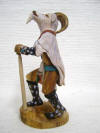 The
Billy Goat is an animal Katsina who appears during the fast
parades and in the summer. He is rarely carved as a Katsina doll
and appears occasionally in plaza dances, always with the
clowns. He is one of the copulation Katsinam and is interested
in copulating with everything in sight. To his large testicles
beneath his loin cloth is attached a sack full of fruit and
other goodies, and toward the end of the dance the aunt of the
man personating the Billy Goat cuts off the sack and gives the
fruit and other goodies to spectators. 8.25" $750
Native American Hopi Carved Billy Goat Fertility Katsina Doll by
Henry Naha The
Billy Goat is an animal Katsina who appears during the fast
parades and in the summer. He is rarely carved as a Katsina doll
and appears occasionally in plaza dances, always with the
clowns. He is one of the copulation Katsinam and is interested
in copulating with everything in sight. To his large testicles
beneath his loin cloth is attached a sack full of fruit and
other goodies, and toward the end of the dance the aunt of the
man personating the Billy Goat cuts off the sack and gives the
fruit and other goodies to spectators. 8.25" $750
Native American Hopi Carved Billy Goat Fertility Katsina Doll by
Henry Naha |
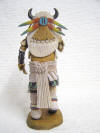 Like
most animal Katsinam, the Buffalo (Mosairu) dances to increase
his kind. This Katsina is very well known and is most powerful.
He can kill any evil thoughts and is a great spiritual
protector. 9" $750 Native American Hopi Carved
Buffalo Great Spiritual Protector Katsina Doll by Henry Naha Like
most animal Katsinam, the Buffalo (Mosairu) dances to increase
his kind. This Katsina is very well known and is most powerful.
He can kill any evil thoughts and is a great spiritual
protector. 9" $750 Native American Hopi Carved
Buffalo Great Spiritual Protector Katsina Doll by Henry Naha |
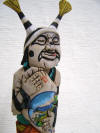 The Clown (Koshare)
Summer Clown, is known by many other names,
including Kaisale (Winter Clown),Tsuku (Second and Third Mesa),
Koyaala, and Hano(First Mesa). The Clown has a complex
ceremonial role, giving wisdom and advice as well as poking fun
at unacceptable behavior. The Clown is said to be a glutton,
always overdoing it whether he is making fun of the dancers,
trying to get the children to behave during ceremonies, or
commenting on Hopi behavior. They are generally amusing and do
things that no Hopi or anyone else would want to be caught
doing. They are often depicted with a watermelon. This one is
holding a prized bag of flour and licking his lips in
anticipation of baked goods. 10.5" $750
Native American Hopi Carved Clown Katsina Doll with Flour Sack
by Richard Gorman The Clown (Koshare)
Summer Clown, is known by many other names,
including Kaisale (Winter Clown),Tsuku (Second and Third Mesa),
Koyaala, and Hano(First Mesa). The Clown has a complex
ceremonial role, giving wisdom and advice as well as poking fun
at unacceptable behavior. The Clown is said to be a glutton,
always overdoing it whether he is making fun of the dancers,
trying to get the children to behave during ceremonies, or
commenting on Hopi behavior. They are generally amusing and do
things that no Hopi or anyone else would want to be caught
doing. They are often depicted with a watermelon. This one is
holding a prized bag of flour and licking his lips in
anticipation of baked goods. 10.5" $750
Native American Hopi Carved Clown Katsina Doll with Flour Sack
by Richard Gorman |
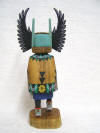 Crow
Mother (Angwusnasomtaka), Mother of the Whipper Katsinam and
considered by many Hopi to be the Mother of all Katsinam. She is
Crow Bride (Angwushahai-i) on Third Mesa probably because she
talks or sings and comes dressed entirely in white. On the other
Mesas she is Crow Mother. She appears during the Bean Dance
(Powamuya) on all three Mesas. During the Powamuya, she
supervises the initiation of the children into the Katsina
Society and carries the yucca whips with which they are struck
by the Hu Katsina. Later in the same ceremony, she leads other
Katsinam into the village bearing in her arms a basket of corn
kernels and bean sprouts to symbolically start the new growing
season. 14.5" $750
Native American Hopi Carved Crow Mother
Katsina Doll by Bennett Sockyma Crow
Mother (Angwusnasomtaka), Mother of the Whipper Katsinam and
considered by many Hopi to be the Mother of all Katsinam. She is
Crow Bride (Angwushahai-i) on Third Mesa probably because she
talks or sings and comes dressed entirely in white. On the other
Mesas she is Crow Mother. She appears during the Bean Dance
(Powamuya) on all three Mesas. During the Powamuya, she
supervises the initiation of the children into the Katsina
Society and carries the yucca whips with which they are struck
by the Hu Katsina. Later in the same ceremony, she leads other
Katsinam into the village bearing in her arms a basket of corn
kernels and bean sprouts to symbolically start the new growing
season. 14.5" $750
Native American Hopi Carved Crow Mother
Katsina Doll by Bennett Sockyma
|
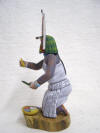 The Cloud Katsinam
are responsible for the rain that moistens the arid Southwest
desert which helps the Hopi people grow the crops needed for
survival. This particular Cumulus Cloud Girl (Tukwinong Mana) is
the sister of Tukwinong. He is basically an assistant to her
brother. The tray in front of her is filled with corn meal and
divided into the four directional colors. The white at the top
of the head represents the top of the clouds; the colors at the
side show the darker sections of the cloud as it takes on water;
the darkest color on the underside of the headpiece and on the
face illustrate the underside of the raincloud where it is
darkest. 11.5" $750
Native American Hopi Carved Cumulus
Cloud Girl Katsina Doll by Tom Collateta The Cloud Katsinam
are responsible for the rain that moistens the arid Southwest
desert which helps the Hopi people grow the crops needed for
survival. This particular Cumulus Cloud Girl (Tukwinong Mana) is
the sister of Tukwinong. He is basically an assistant to her
brother. The tray in front of her is filled with corn meal and
divided into the four directional colors. The white at the top
of the head represents the top of the clouds; the colors at the
side show the darker sections of the cloud as it takes on water;
the darkest color on the underside of the headpiece and on the
face illustrate the underside of the raincloud where it is
darkest. 11.5" $750
Native American Hopi Carved Cumulus
Cloud Girl Katsina Doll by Tom Collateta |
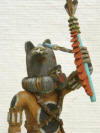 The
Wolf (Kweo) is often seen in the Soyohim Dances accompanied by
the Deer or Mountain Sheep Katsina. He carries a stick that
represents the trees and bushes that he uses to hide in whenever
he stalks his prey. The Wolf Katsina's sharp teeth are always
visible and, sometimes, his lolling tongue. His sharp teeth are
visible to boast the wolf's prowess as a hunter. When he appears
in the dance with the Deer or Mountain Sheep, they are always
wary of him because of their natural relationship as prey for
the Wolf. After the dance, it is customary for the Hopi to offer
the Kweo Katsina cornmeal and, in return, the Kweo Katsina
blesses them on their hunt. 13" $750 Native
American Hopi Carved Wolf Hunter Katsina Doll by Johnny
Lomatewama The
Wolf (Kweo) is often seen in the Soyohim Dances accompanied by
the Deer or Mountain Sheep Katsina. He carries a stick that
represents the trees and bushes that he uses to hide in whenever
he stalks his prey. The Wolf Katsina's sharp teeth are always
visible and, sometimes, his lolling tongue. His sharp teeth are
visible to boast the wolf's prowess as a hunter. When he appears
in the dance with the Deer or Mountain Sheep, they are always
wary of him because of their natural relationship as prey for
the Wolf. After the dance, it is customary for the Hopi to offer
the Kweo Katsina cornmeal and, in return, the Kweo Katsina
blesses them on their hunt. 13" $750 Native
American Hopi Carved Wolf Hunter Katsina Doll by Johnny
Lomatewama |
|
TOP |
|
|
Navajo Kachinas
Sammie Walker Kachinas
Hopi Full Figure Kachinas
Hopi Miniature Kachinas
Hopi Sculpture Katsina
Hopi Old World Style
Kachina
Zuni Fetish
|
KACHINA OF THE MONTH CLUB
Save by ordering
a monthly Kachina
(Three month minimum) |
|
|
|
|
|
|
 |
Top Sellers
|
. |
|
|
 |
Store Categories
|
|
|
NATIVE AMERICAN
Kachinas
Zuni Fetish
Pottery
Artifacts
Drums
Baskets
Gourd Art
Alaska Carvings
Christmas Ornaments
|
| • read more |
|






